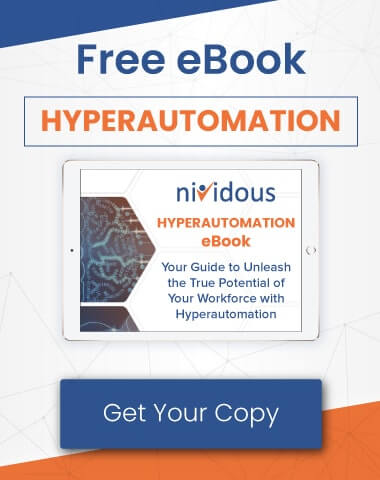What happens when you want to automate certain aspects of your business, but many of your most crucial tasks still require human intervention? You might think you’re out of luck, but perhaps it’s time to consider BPA software for your situation.
Business process automation (BPA) software automates the activities, and repeatable functions that make up an overall business process. What separates BPA from simple robotic process automation (RPA)—which is what most people think of when they hear “automation”—is that not everything has to be done by computers.
For instance, BPA could be applied to an invoicing process wherein a bot extracts relevant content from an invoice, presents it to an accountant for manual review, and then files it in the correct digital storage folder.
The key is that a BPA platform automates both human and bot activities alongside one another, so that bots function more as coworkers than as simple computer programs.
In recent years, companies have increasingly been turning to BPA software solutions over RPA. Business leaders have found that there is often just as urgent a need to automate manual, human-oriented processes as there is to hand over the tedious, repetitive tasks to bots.
However, simply purchasing a BPA system and implementing it in your business isn’t likely to produce the sweeping, positive changes you may hope for. If you want to maximize your return on investment and streamline your business processes as much as possible, it’s going to take some careful planning and strategic decision-making.
The following list should serve as a road map of things to think about before you start shopping around for business process automation software.
Follow this mental road map before you buy BPA software for your business.
1. Understand that technology might not be the best solution to your problem.
The last thing you want to do is spend time and money developing and implementing a BPA system only to have it fail in practice because your problems were not actually in the areas you originally thought.
As an example, let’s say your company is having trouble meeting deadlines, and you suspect it’s because your document system is so disorganized that your employees waste too much time searching for the files they need. It might seem like a centralized document database would solve the problem, but in reality, that solution may not make as much of an impact on your ability to meet deadlines as you think.
In all likelihood, there are several other underlying issues contributing to the problem. Setting up a centralized document management system can certainly help to remove bottlenecks in the process, but it probably won’t be the panacea that fixes your deadline issue.
2. To see if technology is the solution, first identify the biggest problem or problems you want to solve.
To continue the example, “missed deadlines” would seem like your biggest problem. But that surface-level answer actually doesn’t provide much information. What issues contribute to the trouble your company has with deadlines?
Perhaps the lack of document organization is one factor, but now it’s time to identify the others and determine which factor or factors make the most impact.
Are your employees overwhelmed or under-trained? Do you spend a lot of time waiting on people to sign documents and move them to the next step in the process? Or maybe your employees simply aren’t aware of the correct deadlines.
Some of these issues might be better solved with comprehensive employee training or clearer communication around deadlines and expectations rather than with technology.
To further drill down into the need for BPA tools, ask yourself:
3. Are these problems an issue with the process, or something else?
Let’s shift gears and take a look at how BPA could solve a process-oriented problem within the business.
Accounting and human resources are two functional areas within an organization that might contribute to deadlines not being met. Often, those two distinct departments are not well integrated and may suffer from a lack of communication. Emails are notoriously bad for intra-organizational communication, for example.
Because this is a problem with the process, a BPA solution could help in that it would streamline communications between departments and make collaboration speedier and more efficient. But before moving forward, you’ll want to outline a few specific and measurable ways an automated program could improve communications.
It could be that the scattered documents and lack of clear expectations further compound the problem, but if the company simply builds a document database it would not solve the primary issue of miscommunications and missed emails.
4. How would your ideal solution impact the problem?
If you’ve taken the time to think through each of the above considerations, you’ve either come to the conclusion that BPA software isn’t the right answer, or you’ve determined that your problem stems from process-related issues that BPA software could help solve.
If so, it’s time to start thinking about what your BPA solution should look like.
The actual solutions will vary by organization and situation, but these are the details you can work out with your BPA developers once you’ve determined that BPA is indeed the correct path forward.
You can certainly include solutions to other problems you’ve identified along the way as well. Continuing with the example, implementing both a communications solution and a centralized document system may improve efficiency enough to ensure deadlines are met on time.
5. Will you develop your solution in-house or outsource the development?
Some businesses prefer to create a new, in-house department to take charge of building and maintaining custom BPA solutions. This allows the company to focus on BPA as a key part of their strategy moving forward and opens the doors to continuous innovations over time.
This option also requires a lot of time and resources, however, and may not be the best choice for businesses that simply need to solve a problem and then move on. In most cases, outsourcing a BPA solution still allows your company to retain control and customizability over your software without having to hire an entirely new department.
If you decide to outsource your BPA solution, consider working with Nividous.
Process problems often bridge multiple areas within your business. It’s unlikely that your real-life example will look so clean-cut as the example we’ve been working with so far.
One problem you may run into while shopping around is that many BPA platforms can’t handle processes across several different areas of your business. For example, if you have process problems in human resources, vendor management, and your supply chain, you may have difficulty finding another company able to put together a solution that works for these very different issues. More than likely, you’d be forced to choose the top priority and purchase a solution that would only work in that one singular area.
If you’ve run into that problem before, Nividous is your answer. We are able to address business process automation across any functional area within your business. Because we are a company that specializes in building custom BPA solutions, we have the knowledge and flexibility to find the right solution for your situation. You need not be an expert in BPA, because that’s what we’re here for.
Want to find out what the automation process looks like step by step?
Download our Business Process Automation Guide now for a complete overview of automation implementation, including how to measure the success of your efforts.




![The Path Forward for Intelligent Automation [2024 Trends] Blog Feature](https://nividous.com/wp-content/uploads/2024/05/The-Path-Forward-for-Intelligent-Automation-blog-feature-1.webp)
